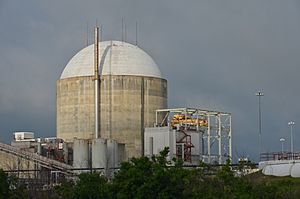H. B. Robinson Nuclear Generating Station facts for kids
Quick facts for kids H. B. Robinson Nuclear Generating Station |
|
|---|---|

H.B. Robinson Nuclear Power Station seen from Lake Robinson
|
|
| Country | United States |
| Location | Darlington County, near Hartsville, South Carolina |
| Coordinates | 34°24′10″N 80°9′30″W / 34.40278°N 80.15833°W |
| Status | Operational |
| Construction began | April 13, 1967 |
| Commission date | March 7, 1971 |
| Construction cost | $408.5 million (2007 USD) |
| Owner(s) | Duke Energy |
| Operator(s) | Duke Energy |
| Website Robinson Nuclear, a pioneer in nuclear energy |
|
The H. B. Robinson Steam Electric Station, Unit 2 is a nuclear power plant located near Hartsville, South Carolina. It uses nuclear energy to create electricity. The plant has one large pressurized water reactor built by Westinghouse. This reactor can produce 735 MW of power.
In the past, this site also had a power unit that used coal. It produced 174 MW of power. This coal unit was stopped in 2012 and taken down in 2016. There was also a smaller unit that used a gas turbine, making 15 MW.
The Robinson plant is named after H. Burton Robinson. He was an important leader at Carolina Power & Light. The plant is right next to Lake Robinson, which is about 2,250 acres big. The Robinson nuclear unit was the first commercial nuclear power plant in the southeastern United States. When it was built, it was the largest of its kind in the world.
Contents
People Living Near the Plant
The Nuclear Regulatory Commission (NRC) sets up two special safety zones around nuclear power plants. These zones help plan for emergencies.
One zone is called the "plume exposure pathway zone." It goes out about 10 miles from the plant. This zone focuses on keeping people safe from breathing in any airborne materials.
The second zone is the "ingestion pathway zone." This zone reaches about 50 miles from the plant. It focuses on making sure food and liquids are safe from any contamination.
In 2010, about 32,675 people lived within 10 miles of the Robinson plant. This was a small increase from ten years before. About 893,536 people lived within 50 miles of the plant in 2010. This was a 10.3 percent increase since 2000. The city of Columbia is about 49 miles away from the plant.
Safety and Environmental Reviews
The NRC regularly checks nuclear power plants to make sure they are safe. They also look at how the plants affect the environment.
In 2003, the NRC published a detailed report about the Robinson plant. This report looked at environmental issues. It was part of the process for the plant to renew its operating license. The report studied the environmental effects of the plant. It also looked at other ways to produce power and how to reduce any negative impacts.
The NRC also reviewed the plant's safety. They checked if the plant followed all the rules for nuclear power plants. They published a safety report in 2004. These reports help make sure the plant operates safely for everyone.
Who Owns and Runs the Plant?
The H. B. Robinson plant is owned and operated by Duke Energy. Duke Energy also owns a company called Progress Energy Inc, which is part of its operations in the Carolinas.
Earthquake Safety
Nuclear power plants are built to be very strong. They are designed to withstand many natural events, like earthquakes. The NRC studies the risk of earthquakes at each plant. In 2010, the NRC estimated the chance of an earthquake strong enough to damage the reactor at Robinson was very low. It was about 1 in 66,667 each year. This shows how carefully these plants are built and monitored for safety.
See also
 In Spanish: Central Nuclear H.B. Robinson para niños
In Spanish: Central Nuclear H.B. Robinson para niños

